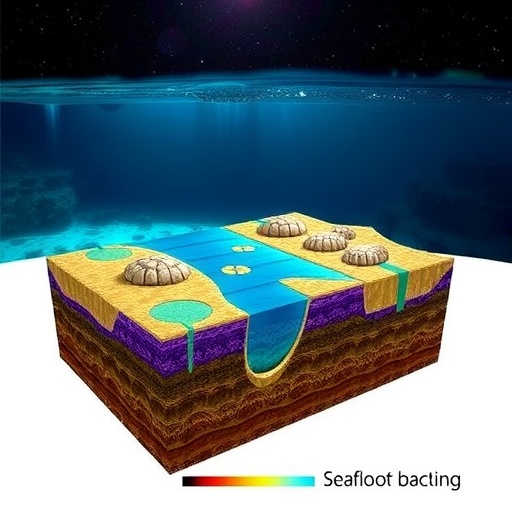The global mid-ocean ridge system, extending over an astonishing 65,000 kilometers, stands as the longest volcanic chain on our planet, relentlessly shaping the oceanic crust that blankets more than two-thirds of Earth’s surface. These submarine mountain ranges serve as sites where magma ascends from the upwelling asthenosphere beneath the ridge axis, giving birth to new oceanic lithosphere. Traditionally, seafloor spreading along these ridges has been interpreted as either symmetrical or asymmetrical, categorizations primarily dictated by the relative plate motion rates on either side of the ridge axis. Such divergence in spreading modes manifests itself through significant variations in crustal thickness and seafloor morphology.
Fast-spreading ridges, characterized by full spreading rates exceeding 80 millimeters per year, alongside intermediate ridges with rates between 55 and 80 millimeters per year, predominantly display symmetrical spreading. In stark contrast, slow- to ultraslow-spreading ridges, with rates ranging from 20 to 55 millimeters per year and below 20 millimeters per year respectively, exhibit a complex combination of both symmetrical and asymmetrical spreading patterns. The underlying drivers for these differences have long been attributed to variations in mantle temperature and spreading rates, assuming the asthenosphere beneath ridges to be compositionally uniform and passively rising to feed magmatic activity.
Challenging this conventional perspective, emerging research underscores the inherent compositional heterogeneity of the asthenosphere. This mantle layer is interspersed with refractory domains—regions that have undergone ancient melt depletion—introducing complex spatial and temporal variations in mantle properties. Such heterogeneity may fundamentally influence magma generation rates and thereby modulate the mode of seafloor spreading. This novel hypothesis posits that the volumetric presence of ancient refractory mantle material actively controls magma flux beneath spreading centers, necessitating a reconsideration of mantle dynamics beneath mid-ocean ridges.
The Mid-Atlantic Ridge (MAR) segment at approximately 23°N presents an exceptional natural laboratory to test this theory. Over the past 3.3 million years, this section of the MAR has undergone a remarkable transition from asymmetric to symmetric spreading, all while exhibiting negligible changes in both mantle temperature and spreading rate. Crucially, this region exposes a near-continuous sequence of abyssal peridotites — residues of the partially melted mantle — that provide invaluable geochemical records of the underlying asthenospheric mantle over geological timeframes. These peridotitic outcrops offer a unique opportunity to scrutinize mantle compositional shifts that parallel changes in spreading mode.
Led by Professor Chuan-Zhou Liu from the Laoshan Laboratory, an international consortium of geoscientists employed an integrative approach combining high-resolution geophysical datasets, detailed geochemical analyses of mantle-derived peridotites and basalts, along with sophisticated numerical modeling. Their findings compellingly demonstrate that during the phase of asymmetric spreading, approximately between 3.3 and 0.4 million years ago, the asthenosphere housed a higher proportion of ancient refractory mantle domains compared to the subsequent symmetrical spreading phase within the last 0.4 million years. This synchronicity between mantle composition changes and spreading regime strongly supports the proposition that heterogeneity within the asthenosphere exerts a critical control over magmatic flux and spreading dynamics.
Beyond elucidating these geodynamic processes, the study provocatively challenges the long-standing assumption of the asthenosphere’s passive role in oceanic lithosphere formation. Instead, the mantle’s compositional heterogeneity signals an active influence on magmatic processes beneath ridges. As Professor Liu eloquently articulates, Earth’s upper mantle resembles a “mixed stew” shaped through billions of years of plate tectonic recycling. Ancient mantle fragments, derived from diverse tectonic environments and embedded deep within the asthenosphere, resist homogenization by mantle convection, preserving their geochemical identities and influencing current mantle melting behavior.
This recognition of mantle heterogeneity has profound implications for understanding magma genesis and the structural evolution of the seafloor, particularly at slow- and ultraslow-spreading ridges where magma supply is inherently limited. Variations in the relative abundance of refractory mantle domains may dynamically adjust the volume and composition of magma produced, thereby modulating the style and symmetry of seafloor spreading. Such a paradigm shift underscores the necessity of integrating mantle compositional data into models of ridge magmatism and tectonics.
Consequently, future research in marine geology and geophysics must pivot towards a more nuanced appreciation of the asthenosphere’s complex internal architecture. The conventional simplistic model of a homogenous mantle source beneath mid-ocean ridges fails to account for observations of variability in crustal thickness, spreading asymmetry, and magmatic output. Incorporating mantle heterogeneity into theoretical frameworks will enhance predictive capabilities and deepen our understanding of plate boundary processes.
Moreover, this paradigm shift invites reevaluation of mantle convection and mixing efficiency. The preservation of ancient refractory domains over geological timescales suggests that mantle convection is less efficient at homogenizing compositional heterogeneities than previously thought. This has ramifications not only for magma generation beneath ridges but also for broader mantle geochemistry and dynamics, including thermal structure and plume-ridge interactions.
The study conducted on the 23°N segment of the Mid-Atlantic Ridge exemplifies how multidisciplinary methodologies—spanning observational, geochemical, and computational approaches—can unravel complex Earth processes. The integration of abyssal peridotite geochemistry with geophysical observations and modeling offers a powerful template for similar studies worldwide, potentially revealing the global extent and influence of mantle heterogeneity on oceanic crust formation.
In summary, the discovery that compositional variability within the asthenosphere directly influences seafloor spreading mode challenges a cornerstone assumption in geology: that the mantle beneath mid-ocean ridges is a uniform, passive source of magma. Instead, the mantle emerges as an active, compositionally diverse participant, whose heterogeneous makeup governs magmatic processes and tectonic manifestations at spreading centers. Recognizing and incorporating this complexity is vital for advancing Earth sciences and decoding the dynamic nature of our planet’s interior.
Subject of Research:
Article Title:
News Publication Date:
Web References: http://dx.doi.org/10.1093/nsr/nwaf385
References: National Science Review, DOI: 10.1093/nsr/nwaf385
Image Credits:
Keywords: mid-ocean ridge, seafloor spreading, asthenosphere, mantle heterogeneity, oceanic lithosphere, magma flux, mantle composition, abyssal peridotites, slow-spreading ridges, mantle convection, magmatism, tectonics




